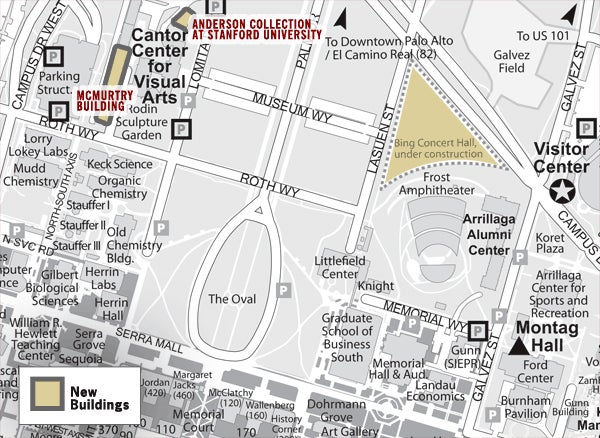|
December 14, 2011
Stanford's Board of Trustees approves sites for two new arts buildings
The Anderson Collection at Stanford University, which will open in 2014, and the McMurtry Building, which will open in 2015, will join the Bing Concert Hall, which will open in 2013, and the Cantor Arts Center as cornerstones of the new arts district. By Kathleen J. Sullivan

The buildings will join the Cantor Arts Center as cornerstones of Stanford's new arts district. (Map: Stanford University) The Stanford University Board of Trustees has approved sites for two new buildings: the McMurtry Building and the museum building for the Anderson Collection at Stanford University. These facilities will be critical to expanding and enhancing the role the arts play throughout campus.
Trustees gave concept and site approval – the first two steps in the university's construction approval process – to the two buildings at their Dec. 12-13 meeting.
The McMurtry Building, the future home of the Department of Art & Art History, will be located on Roth Way near the Cantor Arts Center. The building was named in honor of Burton "Burt" and Deedee McMurtry, longtime friends of the university, who provided a $30 million gift toward its creation. Burt McMurtry (MS '59, PhD '62) is a former chair of the Board of Trustees.
The museum building for the Anderson Collection at Stanford University, which is one of the foremost collections of post-World War II American art, will be located on the corner of Lomita Drive and Campus Drive West, north of the Cantor Arts Center.
The core of the Anderson Collection, 121 works by 86 artists, is being donated to Stanford by Harry W. and Mary Margaret Anderson, and Mary Patricia Anderson Pence, the Bay Area family that collected the art over nearly 50 years.
The arrival of the collection will represent a milestone for the Stanford Arts Initiative, a university-wide effort to enhance and support the arts and creativity and to encourage interdisciplinary collaboration and engagement with the arts throughout campus.
Together with the Bing Concert Hall, which will open in January 2013, the trio of new buildings will join the Cantor Arts Center as cornerstones of the university's new arts district.
"The museum building for the Anderson Collection at Stanford University and the McMurtry Building are magnificent, much-needed additions to this campus," said Leslie Hume, chair of the Board of Trustees. "Like the Cantor Arts Center and the Bing Concert Hall, they make tangible Stanford's commitment to the arts and the central role of the arts in a liberal education. As you arrive on campus and enter this wonderful arts district, you will know immediately that the arts are important to Stanford."
McMurtry Building
Construction of the new $85 million Burton and Deedee McMurtry Building is expected to begin in early 2013 and to be completed in the fall of 2015.
The new building, which will have three stories above ground and a basement, will become the new home of the Art & Art History Department's programs in art practice, art history, film and media studies, and documentary film. Currently, those programs are located in several different buildings on campus.
Diller Scofidio + Renfro, an interdisciplinary design firm that integrates architecture, the visual arts and the performing arts, was selected last April to design the McMurtry Building. The firm, which is based in New York City, was selected for its experience and distinctive approach to architecture for the arts and education. Boora Architects, an Oregon firm considered a leader in the creation of cultural, educational, residential and workplace environments, has been selected as executive architect. Boora was the architect on the recently completed Graduate School of Business campus and the Science and Engineering Quad.
The architectural firms will design spaces to foster interaction and collaboration among students and faculty across artistic disciplines, thereby advancing the integration of the arts into all university departments.
The McMurtry Building will house undergraduate arts practice studios, including painting, drawing, sculpture, experimental media and digital production, photography and printmaking. It also will house screening space, film editing, classrooms and seminar rooms, along with the Art and Architecture Library and gallery space for student and faculty work.
The new 96,000-square-foot-building will be located on land currently occupied by the vacant Anatomy Building, which is anticipated to be demolished in the spring of 2012. The total projected cost, including $2 million for demolition and site work and $83 million for the building, is $85 million.
The building proposal will return to the trustees for design approval in April 2012.
The Anderson Collection at Stanford University
Construction of a $30.5 million museum building for the Anderson Collection at Stanford University is expected to begin in the fall of 2012 and to be completed in early 2014.
The new 30,000-square-foot-building, designed by Richard Olcott of Ennead Architects, a New York City design firm recognized internationally for architectural excellence, will include dedicated museum spaces and a public lobby, as well as offices, a conference room, a library/study area and space for storing art. Olcott and fellow Ennead partner Timothy Hartung lead the design team that also designed the Bing Concert Hall.
The collection is anchored in the work of the New York School and key modern and contemporary artists collected in depth, across media. Major movements represented include Abstract Expressionism, Color Field Painting, Post-Minimalism, California Funk Art, Bay Area Figurative Art, Light and Space and contemporary painting and sculpture.
Represented artists include Helen Frankenthaler, Franz Kline, Morris Louis, Agnes Martin, Robert Motherwell, Nathan Oliveira, David Park, Mark Rothko, David Smith, Frank Stella and Wayne Thiebaud. Key individual works include Jackson Pollock's Lucifer, Willem de Kooning's Woman Standing – Pink, Richard Diebenkorn's Ocean Park #60, Sam Francis' Red in Red, Philip Guston's The Coat II, Ellsworth Kelly's Black Ripe and Clyfford Still's 1957-J No. 1.
The building proposal will return to trustees for design approval in April 2012.
-30-
|